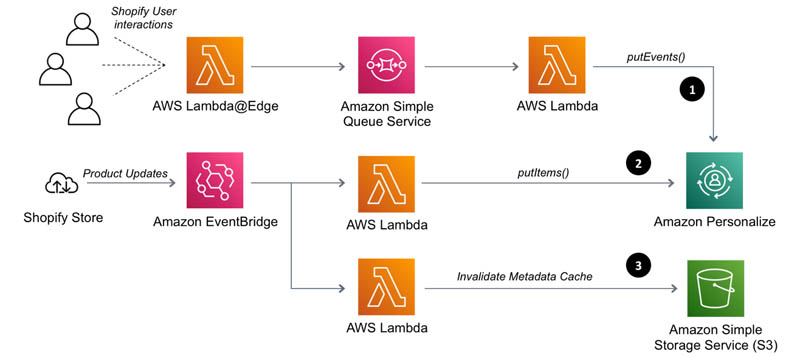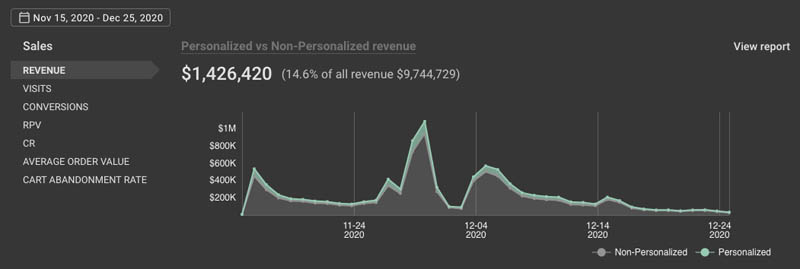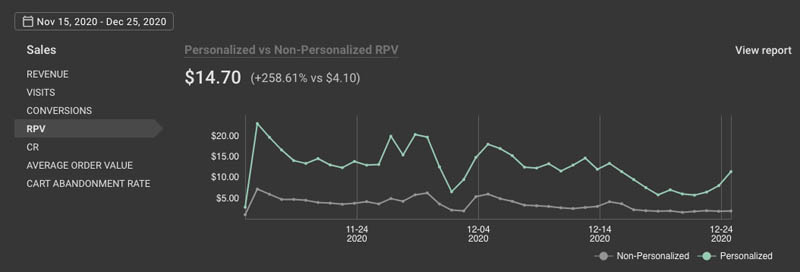This is a guest post by Jeff McKelvey, Principal Development Lead at HiConversion. The team at HiConversion has collaborated closely with James Jory, Applied AI Services Solutions Architect at AWS, and Matt Chwastek, Senior Product Manager for Amazon Personalize at AWS. In their own words, “HiConversion is the eCommerce Intelligence platform helping merchants personalize and optimize shopping experiences for every visitor session.”
platform helping merchants personalize and optimize shopping experiences for every visitor session.”
Shopify powers over 1 million online businesses worldwide. It’s an all-in-one commerce platform to start, run, and grow a brand. Shopify’s mission is to reduce the barriers to business ownership, making commerce more equitable for everyone.
With over 50% of ecommerce sales coming from mobile shoppers, one of the challenges limiting future growth for Shopify’s merchants is effective product discovery. If visitors can’t quickly find products of interest on a merchant’s site, they leave, often for good.
That’s why we introduced HiConversion Recommend, a Shopify Plus certified application powered by Amazon Personalize. This application helps Shopify merchants deliver personalized product discovery experiences based on a user’s in-session behavior and interests directly on their own storefront.
We chose to integrate Amazon Personalize into the HiConversion Recommend application because it makes the same machine learning (ML) technology used by Amazon.com accessible to more Shopify merchants. This enables merchants to generate product recommendations that adapt to visitor actions and behavioral context in real time.
In this post, we describe the architectures used in our application for serving recommendations as well as synchronizing events and catalog updates in real time. We also share some of the results for session-based personalization from a customer using the application.
Private, fully managed recommendation systems
Amazon Personalize is an AI service from AWS that provides multiple ML algorithms purpose-built for personalized recommendation use cases. When a Shopify merchant installs the HiConversion Recommend application, HiConversion provisions a dedicated, private environment, represented as a dataset group within Amazon Personalize, for that merchant.
Then data from the merchant’s catalog as well as the browsing and purchase history of their shoppers is uploaded into datasets within the dataset group. Private ML models are trained using that data and deployed to unique API endpoints to provide real-time recommendations. Therefore, each merchant has their own private ML-based recommendation system, isolated from other merchants, which is fully managed by HiConversion.

HiConversion also creates and manages the resources needed to stream new events and catalog updates from a merchant’s Shopify storefront directly into Amazon Personalize. This enables the real-time capabilities of Amazon Personalize, such as learning the interests of new shoppers to the storefront, adapting to each evolving shopper intent, and incorporating new products in recommendations.
We can also apply business rules using Amazon Personalize filters, enabling merchants to tailor recommendations to a particular category of products, excluding recently purchased products from being recommended, and more.
Serving millions of online shoppers in real time
Creating a premium, self-service Shopify application based on Amazon Personalize required the automation of many processes. Our goal was to democratize access to an advanced product discovery solution, making it easy to use by anyone running their store on Shopify.
To provide a seamless, real-time personalized user experience, an event-driven approach was needed to ensure that Shopify, Amazon Personalize, and HiConversion had the same picture of the visitor and product catalog at all times. For this, we chose to use Shopify’s integration with Amazon EventBridge as well as Amazon Simple Queue Service (Amazon SQS) and AWS Lambda.
The following high-level diagram illustrates how HiConversion Recommend manages the data connections between users and their product recommendations.

As shown in our diagram, AWS Lambda@Edge connects with three independent systems that provide the essential application capabilities:
- Amazon Personalize campaign – A custom API endpoint enabling real-time product recommendations based on Amazon Personalize algorithms.
- HiConversion Rich Data endpoint – This enables hybrid product recommendations based on a mix of HiConversion visitor and web analytics, and Amazon Personalize ranking algorithms.
- Amazon CloudFront endpoint – This enables rapid access to product metadata, like product images, pricing, and inventory, in combination with Amazon Simple Storage Service (Amazon S3).
When a Shopify merchant activates the HiConversion Recommend application, all of this infrastructure is automatically provisioned and training of the Amazon Personalize ML models is initiated—dramatically reducing the time to go live.
Why Lambda@Edge?
According to a 2017 Akamai study, a 100-millisecond delay in website load time can hurt conversion rates by up to 7%. Bringing an application to Shopify’s global network of stores means we had to prioritize performance globally.
We use Lambda@Edge on the front end of our application to track visitor activity and contextual data, allowing us to deliver product recommendations to visitors on Shopify-powered ecommerce sites with low latency. Putting our code as close as possible to shoppers improves overall performance and leads to reduced latency.
We chose Lambda@Edge to maximize the availability of our content delivery network. Lambda@Edge also removes the need to provision or manage infrastructure in multiple locations around the world; it allows us to reduce costs while providing a highly scalable system.
Scaling with EventBridge for Shopify
Our application launched during the busiest time of the year—the holiday shopping season. One thing that stood out was the massive increase in promotional and business activity from our live customers. Due to those promotions, the frequency of catalog changes in our clients’ Shopify stores rapidly increased.
Our original implementation relied on Shopify webhooks, allowing us to take specific actions in response to connected events. Due to the increasing volume of data through our application, we realized that keeping the product metadata and the real-time product recommendations in sync was becoming problematic.
This was particularly common when large merchants started to use our application, or when merchants launched flash sales. The subsequent firehose of incoming data meant that our application infrastructure was at risk of not being able to keep up with the onslaught of web traffic, leading to broken shopping experiences for customers.
We needed a separate, more scalable solution.
We needed a solution that would scale with our customer base and our customers’ traffic. Enter EventBridge: a serverless, event-driven alternative to receiving webhooks via standard HTTP. Integrating with EventBridge meant that Shopify could directly send event data securely to AWS, instead of handling all that traffic within our own application.
Event-driven solutions like EventBridge provide a scalable buffer between our application and our addressable market of hundreds of thousands of live Shopify stores. It allows us to process events at the rate that works for our tech stack without getting overwhelmed. It’s highly scalable and resilient, is able to accept more event-based traffic, and reduces our infrastructure cost and complexity.
The following diagram illustrates how HiConversion Recommend uses EventBridge to enable our real-time product recommendation architecture with Amazon Personalize.

The architecture includes the following components:
- The Amazon Personalize putEvents() API enables product recommendations that consider real-time visitor action and context. Visitor activity and contextual data is captured by the HiConversion web analytics module and sent to a Lambda@Edge function. We then use Amazon SQS and a Lambda function to stream events to an Amazon Personalize event tracker endpoint.
- EventBridge notifies Amazon Personalize about product catalog changes via a Lambda function dedicated to that purpose. For example, Amazon Personalize can recommend new products even when they don’t have prior order history.
- EventBridge also keeps Shopify product metadata in sync with HiConversion’s metadata stored in Amazon S3 for real-time delivery via Amazon CloudFront.
Ultimately, EventBridge replaced an undifferentiated custom implementation within our architecture with a fully managed solution able to automatically scale, allowing us to focus on building features that deliver differentiated value to our customers.
Measuring the effectiveness of session-based product recommendations on Shopify
Many product recommendation solutions are available to Shopify merchants, each using different types of algorithms. To measure the effectiveness of session-based recommendations from Amazon Personalize, and to indulge our data curious team culture, we ran an objective experiment.
Selecting a technology in todays’ economy is challenging, so we designed this experiment to assist merchants in determining for themselves the effectiveness of Amazon Personalize session-based algorithms.
We started with a hypothesis: If session-based recommendation algorithms can adapt to visitors’ actions and context in real time, they should produce improved results when visitor intent and preferences suddenly shift.
To test our hypothesis, we identified a predictable shift in intent and preferences to:
- Visitor preferences – Before the holiday season, visitors are typically buying something for themselves, whereas during the holiday season, visitors are also buying things for others.
- Visitor profiles – Visitor profiles before the holiday season are different than during the holidays. The holiday season sees more new visitors who have never purchased before and whose preferences are unknown.
- Brand promotions – During the holiday season, brands aggressively promote their offerings, which impact visitor behavior and decision-making.
To evaluate our hypothesis, we compared pre-holiday product recommendation results with results from peak holiday time. One of our clients, a large and successful cosmetics brand, found that product recommendation improved Revenue Per Visitor (RPV) +113% when compared to pre-holiday.
Pre-holiday product recommendation results
First, we looked at the percentage of overall revenue impacted by personalized product recommendations. For this client, only 7.7% of all revenues were influenced by personalized product recommendations compared to non-personalized experiences.

Second, we looked at the RPV—the most important metric for measuring new ecommerce revenue growth. Conversion Rate (CR) or Average Order Value (AOV) only tell us part of the story and can be misleading if relied on alone.
For example, a merchant can increase the site conversion rate with aggressive promotions that actually lead to a decline in the average order value, netting a drop in overall revenue.
Based on our learnings, at HiConversion we evangelize RPV as the metric to use when measuring the effectiveness of an ecommerce product recommendation solution.
In this example, visitors who engaged with recommended products had over 175% higher RPV than visitors who did not.

Our analysis illustrates that session-based product recommendations are very effective. If recommendations weren’t effective, visitors who engaged with recommendations wouldn’t have seen a higher RPV when compared with those that didn’t engage with recommended products.
Peak-holiday product recommendation results.
A leading indicator that session-based recommendations were working was the increase in the percentage of overall sales influenced by personalized recommendations. It grew from 7.7% before the holidays to 14.6% during the holiday season.

This data is even more impressive when we looked at RPV lift. Visitors who engaged with personalized recommendations had over 259% higher RPV than those who didn’t.

In comparison, session-based recommendations over-performed pre-holiday RPV lift.
| Before Holidays | During Holidays | Relative Lift | |
| RPV Lift | 175.04% | 258.61% | 47.74% |
New revenue calculations
Based on the preceding data points, we can calculate new revenues attributable directly to HiConversion Recommend.
| Before Holidays | During Holidays | |
| RPV (personalized) | $6.84 | $14.70 |
| RPV (non-personalized) | $2.49 | $4.10 |
| Visits (personalized) | 33,862 | 97,052 |
| Visits (non-personalized) | 1,143,147 | 2,126,693 |
| Revenue attributable to HiConversion Recommend | $147,300 | $1,028,751 |
| % of all revenue attributable to HiConversion Recommend | 5% | 10% |
These calculations make a strong case for the high ROI of using HiConversion Recommend, when considering the new revenue potential created by session-based recommendations.
Conclusions
Product recommendations for Shopify—powered by Amazon Personalize—are an effective way of engaging and converting more new shoppers. To prove it, we have built a challenge to show you how quickly you can achieve measurable, positive ROI. To get started, sign up for the 7-Day Product Recommendation Challenge.
A well-designed and scalable solution is particularly important in serving a massive, global customer. And because session-based, real-time personalization is a differentiator to drive ecommerce growth, it’s extremely important to consider the best technology partner for your business.
About the Authors
Jeff McKelvey is the Principal Development Lead at HiConversion.
James Jory is a Solutions Architect in Applied AI with AWS. He has a special interest in personalization and recommender systems and a background in ecommerce, marketing technology, and customer data analytics. In his spare time, he enjoys camping and auto racing simulation.
Matt Chwastek is a Senior Product Manager for Amazon Personalize. He focuses on delivering products that make it easier to build and use machine learning solutions. In his spare time, he enjoys reading and photography.
